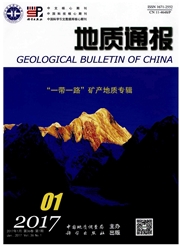

 中文摘要:
中文摘要:
滇西南腾冲地块中部的梁河盆地地层出露较好,阶梯状地貌发育,并有多期火山活动,是开展新构造研究的良好地点。综合地表调查与年代学研究结果发现,该盆地主要发育新近纪南林组与芒棒组和第四纪地层,各时代地层的沉积及变形特征都明显不同,其中最早的盆地沉积南林组地层的固结及变形程度高;芒棒组的固结及变形程度则稍差;第四纪地层没有固结或弱固结,且基本无变形。该区在地貌上共发育7级阶(台)地,各级地貌面主要形成于早更新世以来。该区的火山活动至少包括3.5~5.0Ma、2.3~2.9Ma、1.0~1.5Ma及0.5~0.7Ma四期。综合梁河盆地中地层、地貌、火山等方面的新构造运动标志,将腾冲地块的新构造运动初步划分为3个阶段:①5Ma之前,盆地开始断陷,南林组沉积及掀斜变形;②5~2Ma,盆地进一步扩张,芒棒组沉积及掀斜变形,并伴随火山活动;③2Ma以来,盆地萎缩抬升,形成多级台地及阶地,并伴随多期火山活动。
 英文摘要:
英文摘要:
The well exposed strata, the terraced multi-platforms and multi-period volcanic activity in Lianghe Basin indicate neotec?tonics of central Tengchong block. The each era sediments and deformation show different characteristics, that is the Miocene Nanlin Formation has the highest degree of consolidation and deformation, the Pliocene Mangbang Formation higher and the Quaternary Strata a little or no. The seven levels terrace are found in which the 5th terrace is most well preserved. There are at least four period volcanic activity in Lianghe Basin, including 3.5~5.0Ma, 2.3~2.9Ma, 1.0~1.5Ma and 0.5~0.7Ma from old to young respectively. Ac?cording to the new chronology study results, the neotectonic movement episodes can be divided into three period: ①before 5Ma, in?cluding basin formation, consolidation and deformation of Nanlin formation; ②5~2Ma, consolidation and deformation of Mangbang formation along with multi period volcano activity;③after 2Ma, multi-stage platforms and terraces formation with multi period vol?cano activity.
 同期刊论文项目
同期刊论文项目
 同项目期刊论文
同项目期刊论文
 期刊信息
期刊信息
